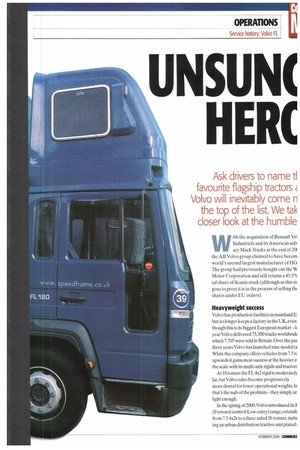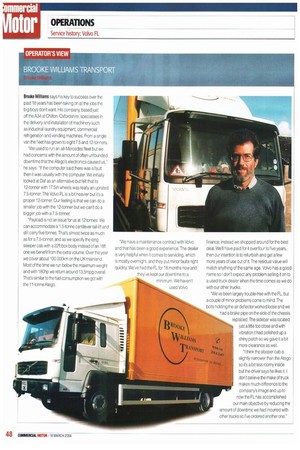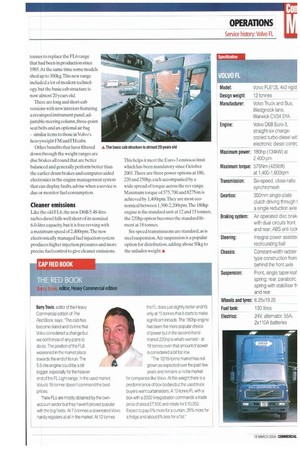Ask drivers to name ti favourite flagship tractors Volvo will
Page 47

Page 48

Page 49

If you've noticed an error in this article please click here to report it so we can fix it.
inevitably come n the top of the list We tak closer look at the humble
With the acquisition of Renault Vel Industriels and its American sub: ary Mack Trucks at the end of 20( the AB Volvo group claimed to have becom world's second largest manufacturer of HG The group had previously bought out the W Motor Corporation and still retains a 45.5% tal share of Scania stock (although as this is goes to press it is in the process of selling th( shares under EU orders).
Heavyweight success Volvo has production facilities in mainland E but no longer keeps a factory in the UK, even though this is its biggest European market —11 year Volvo delivered 75,300 trucks worldwide which 7.705 were sold in Britain. Over the pas three years Volvo has launched nine model ra While the company offers vehicles from 7.5 tc upwards it gains most success at the heavier ei the scale with its multi-axle rigids and tractor5 At 18 tonnes the FL 4x2 rigid is moderately lar, but Volvo sales become progressively more dismal for lower operational weights. In that's the nub of the problem —they simply ar light enough.
In the spring of 2000,Volvo introduced its F (Forward-control/Low-entry) range,extendb from 7.5 4x2s to a three Wed 26-tonner,inclu ing an urban distribution tractive unit plated;
"We have a maintenance contract with Volvo and that has been a good experience. The dealer is very helpful when it comes to servicing, which is mostly overnight, and they put minor faults right quickly. We've had the FL for 18 months now and they've kept our downtime to a minimum. We haven't used Volvo finance; instead we shopped around for the best deal. We'll have paid for it over four to five years, then our intention is to refurbish and get a few more years of use out of it. The residual value will match anything of the same age. Volvo has a good name so I don't expect any problem selling it on to a used truck dealer when the time comes as we do with our other trucks.
"We've been largely trouble-free with the FL, but a couple of minor problems come to mind. The bolts holding the air deflector worked loose and we had a brake pipe on the side of the chassis eplaced. The sidebar was located just a little too close and with vibration it had polished up a shiny patch so we gave it a bit more clearance as well.
"I think the sleeper cab is slightly narrower than the Atego so its a bit less roomy inside but the driver says he likes it. I don't believe the make of truck
.1 makes much difference to the
company's image and up to now the FL has accomplished our main objective by reducing the amount of downtime we had incurred with other trucks so I've ordered another one."
tonnes to replace the FL6 range that had been in production since 1985.At the same time some models shed up to 300kg.This new range included a lot of modern technology, but the basic cab structure is now almost 20 years old.
There are long and short-cab versions with new interiors featuring a revamped instrument panel, adjustable steering column, three-point seat belts and an optional air bag similar items to those in Volvo's heavyweight FM and FH cabs.
Other benefits that have filtered down through the weight ranges are disc brakes all round that are better balanced and generally perform better than the earlier drum brakes and computer-aided electronics in the engine management system that can display faults, advise when a service is due or monitor fuel consumption.
Cleaner emissions
Like the old FL6. the new D6B 5.48-litre turbo-diesel falls well shod of its nominal 6.0-litre capacity, but it is free revving with a maximum speed of 2,40Orpm.The new electronically managed fuel injection system produces higher injection pressures and more precise fuel control to give cleaner emissions This helps it meet the Euro-3 emission limit which has been mandatory since October 2001.There are three power options at 180, 220 and 250hp.each accompanied by a wide spread of torque across the rev range. Maximum torque of 575.700 and 827Nm is achieved by 1,40Orpm.They are most economical between 1500-220Orpm.'The 180hp engine is the standard unit at 12 and 15 tonnes: the 220hp option becomes the standard fitment at 18 tonnes.
Six-speed transmissions are standard,as is steel suspension.Air suspension is a popular option for distribution, adding about 50kg to the unladen weight.•








































































































































































































































